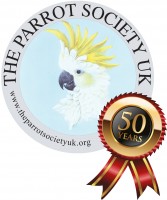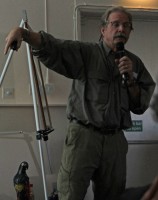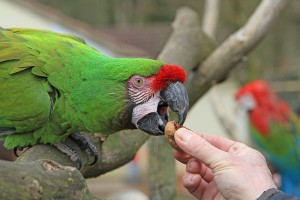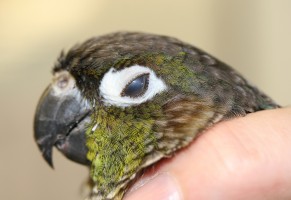The Parrot Society UK
50th Anniversary Seminar Part Two
PS 50TH ANNIVERSARY CONVENTION PART TWO
Alan K Jones BVetMed MRCVS, PSUK Chairman

The morning continued with our prestigious speaker from the USA, Dr Mark Stafford. The atrocious weather conditions of the day before had caused travel disruption for many of our guests, but none more so than Dr Stafford and his wife Marie. They flew in from America to London’s Heathrow on Friday morning to be told that their connecting flight to Manchester had been cancelled owing to the strong winds and heavy rain. A possible alternative of a train from Euston to Manchester was also cancelled because of a landslide. Eventually British Airways managed to fly this exhausted couple from Heathrow to Cork, and then back to Manchester, from where they caught a train to Chester. They arrived at their hotel at nearly 11.30 pm, with no luggage other than their carry-on bags – this had been misdirected amidst all the chaos! Fortunately their luggage was delivered to the hotel late on Saturday – after his presentation.
The following morning saw Mark, bright-eyed and cheerful, walking round to the corner shop to pick up some essential toiletries, and then there he was at the podium of our seminar at 11.30 am, ready and raring to go, in the clothes he had travelled in! He appeared completely un-phased by the whole experience, and started by describing his background. Dr Stafford is a dentist by training, but also the founding director and president of Parrots International, which is a not-for-profit organisation dedicated to promoting and fostering international co-operation in the conservation of endangered parrot species. Its basic premise is that “Conservation happens in the wild”. Mark Stafford began by showing pictures of some of his collection of macaws and cockatoos, and posed the question “What creates this enthusiasm that we all have for parrots?” After mentioning the work of Parrots International and its conferences, acknowledging along the way the contribution made by PSUK to corn subsidies etc in parrot conservation in South America, he generously waived any claim to travel expenses offered by the Society for his attendance at this weekend.

Mark Stafford emphasising a point
He then launched into the most fascinating, fact-filled presentation entitled “What’s so special about parrots that makes them worth conserving?” At the end of this breathtaking lecture, we were left in no doubt that they are indeed very special birds. Dr Stafford’s talk examined the intellectual, social, physiological and anatomical adaptations of parrots and how these adaptations relate to their lives in the wild and in captivity.
He started with confirmation of the evolution of birds from reptilian dinosaurs, with parrots and Corvids (crows) reaching the pinnacle of intelligence and social activity amongst avian species. Parrots can learn and perform quite complex tasks – Mark cited the work of Dr Irene Pepperberg with her African grey parrot Alex – and they have curiosity, use tools, and complex social interaction. In fact, captive bred parrots that are not allowed social stimuli, by being brought up alone; suffer from retarded development and a lack of psittacine social skills in later life. They have complex vocal ability, with latest research suggesting that several sounds can be combined to form meaningful ‘sentences’. Parrots eagerly learn ‘human’ communication, yet no human has ever learned the language of another species. Dr Stafford illustrated this with some entertaining video clips of conversations and interactions with his own parrots. Geographical dialects are recognised in parrot groups, but these are learned from adults in the flock, rather than being instinctive. Most parrot species roost communally, and many species (especially in South America) indulge in co-operative breeding activity, with sharing of the raising of young, nest building and mutual protection. The use of simple tools has been observed in the wild in large macaws, Kea, Palm Cockatoo and the African grey parrot, as well as being reported regularly in companion parrot species such as Goffin’s Cockatoos and the Greater Vasa. Many video clips of ‘dancing’ parrots demonstrate that they have a genuine innate sense of rhythm.
Then followed the first of some fascinating facts and figures relating to the anatomy and physiology of intelligence. Mark told us that the total brain density of parrots is twice that of primates, whilst the grey matter (important in processing conscious information) has four times the density in parrots compared with primates. Further, humans and chickens have just 19% of their total brain neurons in the grey matter, whereas parrots have 70% of their neurons in this processing section of the brain. All this means that there is a greater density of processing power in a smaller volume, offering some four times the processing speed and reaction time in a parrot against that of a mammal. This obviously has significant influence on their ability to fly rapidly through trees and to evade predators.
Mark then moved on to the special vision of parrots. Humans have three types of colour receptor cells (or cones) in their eyes, capable of detecting Red, Green and Blue wavelengths of light. Combinations of these three basic colours give us the spectrum that we see. Parrots however have four types of cone, with the fourth receiving ultra-violet wavelengths. Moreover, in parrot retinas, each cone has four oil-droplet filters, being respectively polarising, clear, yellow and red. Thus – we have just three simple colour receptors, whilst parrots have four types of cone, each with four filters, giving an effective sixteen combinations. They can see more colours and shades than we can, as well as UV and polarised light. A parrot can look up into an intensely bright sky and see a distant dot as a hazardous bird of prey, while we will be simply squinting against the dazzling light.
Anyone who is colour blind will know that taking away just one of our colour receptors makes a big difference to our visual perception. Ultraviolet light does not penetrate through glass, so imagine then how a parrot’s normal perception of its world will be drastically altered when housed indoors. No wonder that parrots want to take flight and escape into the rich colourful outside world when they see an open window or door! There is no doubt that a parrot’s world looks very different to a human’s world.
This perception of ultraviolet light is important both for feeding and courtship in parrots. Ripe fruit glows with UV reflectance: Mark showed pictures of him walking around a supermarket with his Green-winged Macaw, with the bird ‘identifying’ the ripest apples! Male and female plumage that appears identical to us with our limited faculties will be very different to a courting parrot’s eyes. Thirty Blue-fronted Amazon parrots were studied under UV light, with particular reference to their wing and head feathers. These are areas of the body most used in courtship display. Sex of the birds was determined with 100% accuracy using the colour difference. Patagonian Conures were studied in a similar way, and cock birds were found to reflect far more bright green under UV light, while hens reflected more blue, and their red abdominal patches appeared different between the sexes with UV reflectance.
Returning to the evolution of birds from dinosaurs, Mark stated that the first feathers were found as modified scales in a 400 lb ostrich-like creature, and that these primitive feathers appeared only in the adult creature. This suggests that feathers were first used for display and courtship purposes, rather than for flight. Every feather on a bird’s body may be individually moved and controlled voluntarily by muscle contractions.
Dr Stafford then moved on to the methods of colour production in birds’ plumage. Melanin is a pigment providing black colour, but blue colour is demonstrated simply by the refraction of white light through the hollow structure of feathers. There is no pigment involved here. Equally, white is shown by complete reflection of light when no melanin or other pigments are present. Most birds produce yellow and red pigments from carotenoids, which are largely obtained from dietary components, whereas parrots manufacture yellow and red psittacofulvins.
Having dealt with colour, Mark returned to visual acuity by explaining that humans have muscles in the eye that change the shape of the lens, allowing focus on objects just 8” from the eye. Parrots however can not only change the shape of their lens, but also have muscles that influence the cornea, meaning that they can focus on something as close as just ½” from the eye, right up to infinity. Watch your parrot holding something in its foot while it eats, and observe the eye flicking from a downward view of the food up to watch its surroundings.

Military Macaw takes a proffered nut, keeping an eye on the treat as well as potential danger. Bright red brow feathers coloured with manufactured pigment, shades of green resulting from a combination of yellow pigments and blue refracted light.
More facts and figures followed swiftly: human retinas have some 200,000 cones per mm2 but parrots have twice as many at 400,000 cones per mm2. Moreover, humans have just one nerve fibre (axon) serving 7 cones, to take impulses to the brain. Parrots have one axon for each cone, thus having seven times more efficient nerve fibre transmission. The central part of the retina – the fovea – is the area of sharpest focus in the eye, and this is far larger in parrots than it is in man. There is also a major difference in image persistence – the ability to detect flicker. Humans can see images changing no faster than 50 or 60 cycles per second (hertz), and films on television will therefore appear to us as a fluid motion. Parrots can detect up to 140-160 hertz, so such a film would appear as a series of rapidly changing individual pictures.
All these facts, coupled with the superior processing power of the brain mentioned earlier, ensure that parrots are successful at avoiding danger and flying at speed past obstacles.
Still with eyes, Mark told us next that parrots have voluntary control over the muscles that dilate and constrict the pupils of their eyes. This ‘flashing’ or ‘pinning’ is used to communicate moods such as anger, fear or excitement.
In common with most prey species, parrots’ eyes are on the sides of their heads, giving a 330° angle of vision. Not only that, but their brains can process and track two separate images simultaneously on either side of the head. Against that however is that the angle of forward binocular vision is very small, so judging distance for parrots is more difficult. They compensate for this by ‘sampling’ – moving the head back and forth quickly and comparing the different angles of view of an object to calculate distance away.
Finally, there is the ‘third eyelid’, or nictitating membrane – a semi-transparent structure that can protect the eye against dust or wind when the bird is flying.

Head of a Pyrrhura Conure, showing the nictitating membrane, or 'third eyelid'.
Dr Stafford moved on to other senses, describing how the delicate ‘hair cells’ in a parrot’s ear are capable of regenerating if damaged, unlike those of humans which cannot, leading to permanent loss of hearing. The apparently simple syrinx at the base of the windpipe is the organ of voice production. This contains two separate membranes, each with their own neural connections, allowing the production of two separate, simultaneous sounds. Humans utilise just 2% of the air passing through the larynx for sound production, whereas parrots are able to make use of 100% of the airflow. Now wonder their ear-splitting vocalisations may be heard for miles!
The powerful and characteristic hooked beak of parrots is well supplied with nerve endings sensitive to pressure, touch, texture, resilience, temperature and pain. Both upper and lower portions of the beak articulate separately against the skull, and they grow continuously throughout life.
Parrots’ body temperature is higher than humans, at 104°F (40°C), allowing nerve impulses to travel faster and muscle action to be stronger, once again aiding explosive flight and fast reactions. The disadvantage is that energy expenditure is high. Heat may be generated by shivering the pectoral muscles, and the body feathers make a very efficient insulating layer to retain body heat. Conversely, parrots seek out shade and are inactive in the heat of midday. The feet and legs, having just scales but no feathers, run the risk of losing heat as blood flows through them. This is overcome with a counter-current exchange mechanism, whereby the arteries and veins intertwine, so that warm arterial blood flowing to the toes warms returning venous blood. Parrots can also reduce blood flow to one foot at a time while resting, and they will stand on one leg and raise the other up into the plumage to retain heat. This ability to stand on one leg is assisted by a ‘ratchet’ action in the tendons, allowing the locking of the limb without sustained muscle contraction.
Parrots’ heart and circulatory systems, as well as their unique lungs and air-sac respiratory cycle, all contribute to greater efficiency in blood flow and gaseous exchange compared with mammals.
Dr Stafford concluded this epic presentation by saying that “Parrots run supercharged, but they don’t burn out”. All his fascinating facts and figures demonstrated these birds’ unique superiority over mammals of a similar size and weight, yet their potential life spans are so much longer. Even so, in captivity, potential longevity is not always reached. A study of parrots kept in zoological collections revealed that a few individual birds had lived for 30 – 90 years, yet the average lifespan of zoo parrots was no more than 12 years.
Mark Stafford undoubtedly proved his point that ‘parrots are worth conserving’, and left us all over-awed with the depth of knowledge and information presented on these fascinating birds.
Please move on to Part 3
